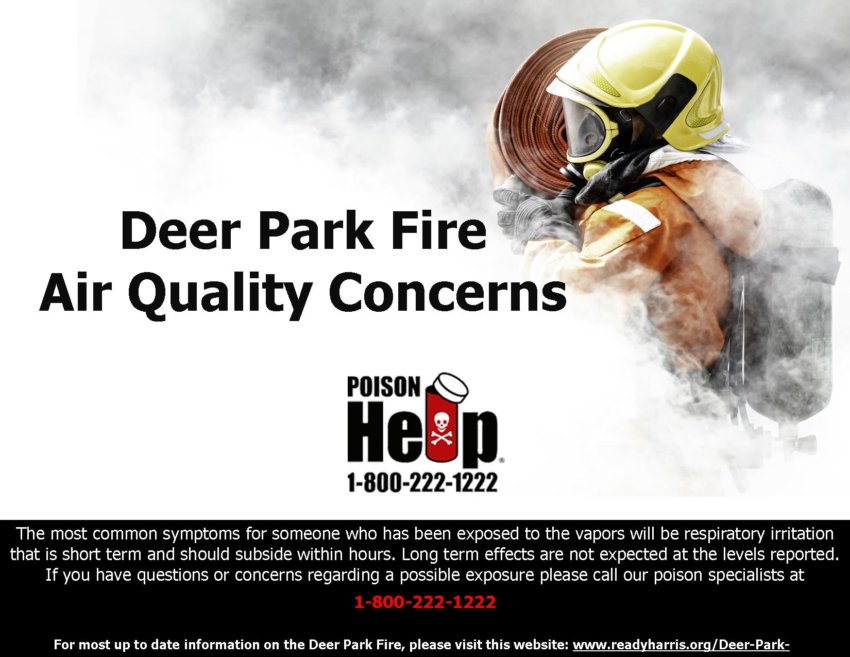The South Texas Poison Center at UT Health San Antonio is part of the Texas Poison Network. With the Deer Park chemical fire in suburban Harris County making headlines in recent days, the state network provided the following information as a service to the public statewide. Shawn Varney, M.D., director of the South Texas Poison Center, shared the information with the UT Health San Antonio online Newsroom on March 21.
Q. What are the exposure agents?
A. Benzene, toluene, xylene, naphthalene. These are all chemicals called volatile organic compounds (VOCs) used in the petrochemical industry (petroleum refining, and coke and coal chemical manufacturing) and in the manufacturing of rubbers, lubricants, dyes, detergents, drugs and other chemicals.
Q. What are the common symptoms of exposure?
A. The main symptoms of exposure appear to be respiratory irritation, throat irritation, eye irritation, headache, dizziness and skin irritation.
- These are short term and should subside within hours.
- Long-term effects at the levels reported are not expected.
- A public concern is the risk of cancer (AML – acute myelogenous leukemia) from benzene exposure. This is essentially non-existent at the current measured levels (1.3 parts per million, or PPM) for a few hours.
- The threshold lowest risk for acute myelogenous leukemia from air benzene is 200 ppm-years, which means it would require 200 years of 8 hours per day exposure at a level of 1 ppm to reach the lowest threshold risk for AML.
- The levels that have been reported currently are far below the levels required to cause cancer.
Q. What is the half-life of benzene in humans?
A. 15-20 hours.
Q. What happens with the benzene we inhale?
A. Most of the benzene inhaled is exhaled.
Q. What does the poison center recommend?
A. Symptomatic treatment of throat irritation, eye irritation, headache, dizziness, skin irritation. No laboratory tests are needed. Benzene levels are not necessary.
Q. Will I get cancer from this?
A. There is NO clinically significant concern for leukemia (AML = acute myelogenous leukemia) from exposure to benzene at levels seen in the Deer Park fire. The levels that have been reported currently are far below those required to cause cancer. See above.
Q. Do I need to wear a mask?
A. A mask is not necessary.
Q. Do I have to stay indoors?
A. At this time, follow the recommendations the state agencies have released. An abundance of precaution is being employed for your safety.
Q. When will the shelter in place be lifted?
A. This will be determined by the state and local/county government officials in the field monitoring the air quality levels; you can get more information at www.readyharris.org/Deer-Park-Fire.
Q. Why were the schools closed?
A. While there is currently no data to support dangerously elevated levels of any of the chemicals released, incident command decision makers decided to close schools based on having limited data and wanting more information prior to declaring schools completely safe. Significant precaution was employed for public safety.
Q. Does anything change for people in the Deer Park area being exposed to the smoke?
A. No. If necessary, seek supportive care. No specific testing is needed.
Q. Should first responders with symptoms be treated differently?
A. First responders who have been exposed for hours or have more serious symptoms should seek medical care.
Q. Can you give me any additional information?
A. We are still gathering data on an hourly basis. Additional data sources:
- For the most up-to-date information on the Deer Park fire, please visit this website: www.readyharris.org/Deer-Park-Fire.
- If you have questions or concerns regarding a possible exposure, please call our poison specialists at 1-800-222-1222.
Our recommendations may change according to the data we receive as the day progresses.
Reference: Wong: Risk of acute myelocytic leukemia in workers exposed to benzene. Occupational Environmental Medicine 1995;52:380–384


